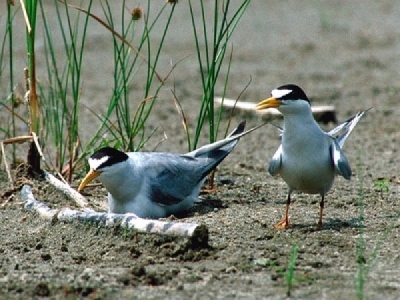
Posted on January 23, 2018
By Jessica Holdman, Grand Forks Herald
The U.S. Army Corps of Engineers is aiming to build up a sandbar on the Missouri River near Washburn, about 40 miles north of Bismarck, for threatened and endangered birds.
As part of its efforts to reinvigorate least tern and piping plover populations, the corps is starting the approval process for a $2 million project that would increase the two birds’ breeding habitats on the Missouri River.
In the past, the corps has killed off vegetation on river sandbars to create the sandy open areas the birds prefer. For the first time on the stretch of river between Gavins Point Dam, on the border of Nebraska and South Dakota, and the Garrison Dam, the agency plans to dredge up nearby sand in order to heighten and widen a submerged sandbar, providing more space for the birds to nest, said the corps’ Omaha Districts Emergent Sandbar Habitat Program Director Jeremy Szynskie.
A similar project took place near Vermillion, S.D., in 2009. From one year to the next, the area went from one nest to more than 50.
The corps has identified three locations for a smaller, 30-acre project, Szynskie said.
The first potential site is near Fort Clark State Historic Site, the second is upstream of the bridge at Washburn and the third is near Cross Ranch State Park. The second two sites would be made up of two smaller sandbars with the channel cutting through the middle; the first would be one large sandbar.
When choosing sites, the corps ruled out sandbars between the Garrison Dam and Knife River due to flow rates from the dam. It also avoided a 15-mile stretch around Bismarck due to recreation and any area with a width less than 630 feet. That left the agency with about 4 miles of river from which to choose, Szynskie said.
From the Garrison Dam to the headwater of Lake Oahe, the Corps says there were 266 adult piping plovers and 197 least terns in 2017. For the northern region, which includes Lake Sakakawea to Lake Oahe, there were 633 piping plovers and 321 least terns.
Szynskie said the corps often gets questions on why more sandbars are needed. There are already more than 450 acres of sandbar between Garrison Dam and Lake Oahe headwaters, which meets the corps’ goal.
But Szynskie says corps modeling shows sandbars eroding over time, to the point the 450-acre goal won’t be met by 2019, based on current projections.
There is also an issue with how long these projects last. These man-made sandbars erode just like those formed naturally. The one built up near Vermillion eroded away with the flooding that took place in 2011.
“The river changed so much after the 2011 flood,” Szynskie said.
The projected lifespan for the built-up sandbars is three to five years, so the corps has to keep rebuilding them to maintain its goals, he said.
The proposed Washburn project would go out for bids in 2018 for construction after the 2018 nesting season, pending availability of funds. It would need to be completed prior to the start of the 2019 nesting season.
The proposed project is in the public comment stage of the National Environmental Policy Act process. About 30 people were present at a public meeting on the project held in Bismarck last week. The audience consisted mostly of government employees and contractors interested in putting in bids for the construction.
To submit public comments electronically, email cenwo-planning@usace.army.mil.
Source: Grand Forks Herald





